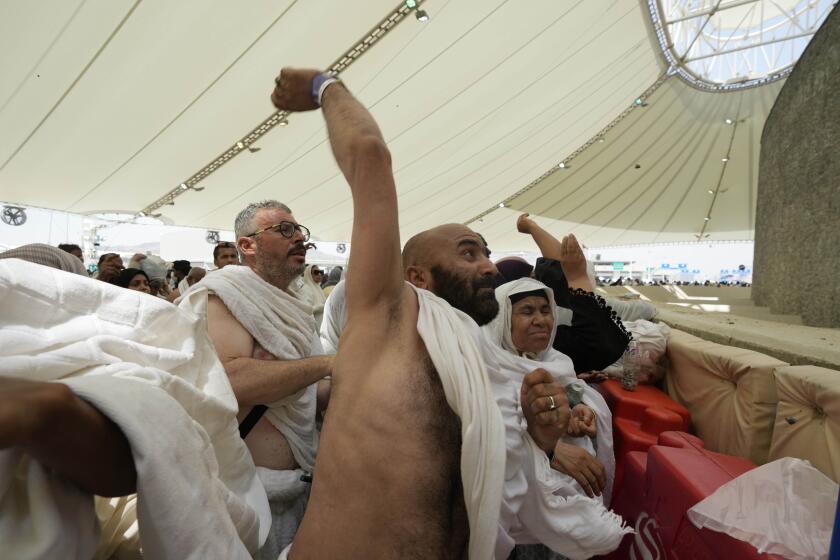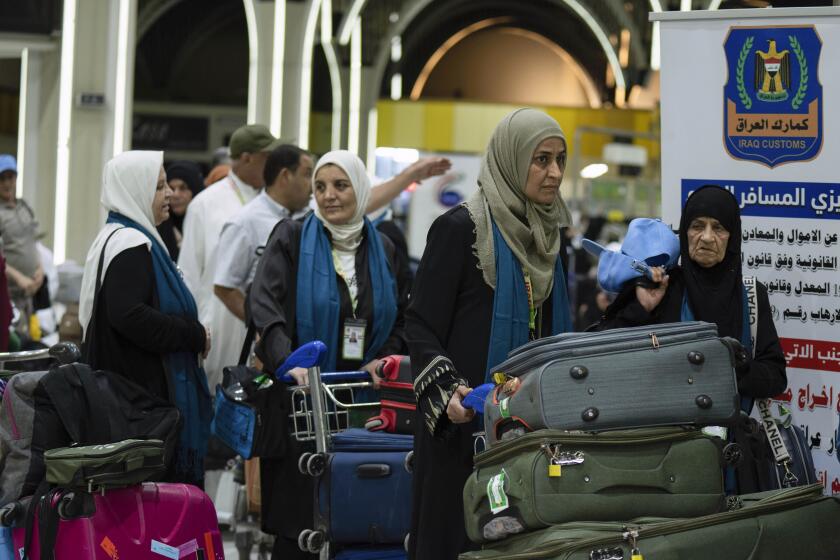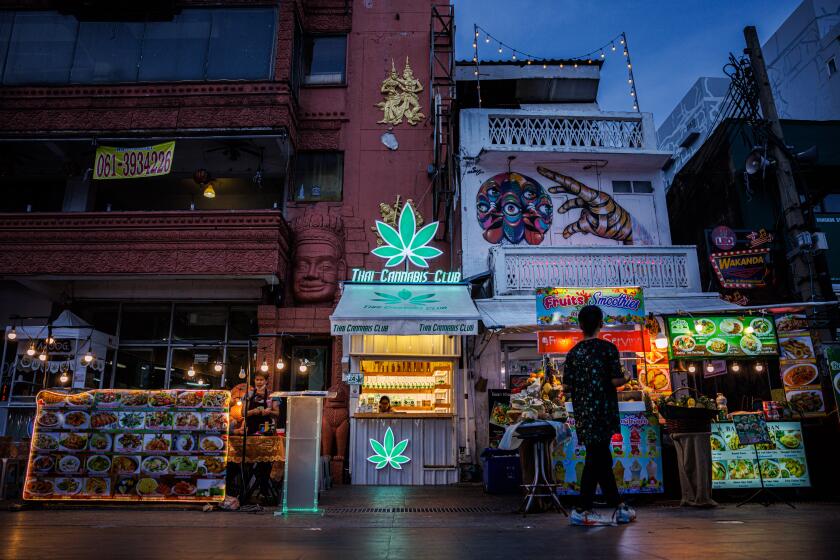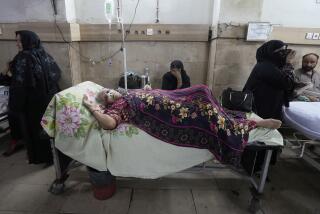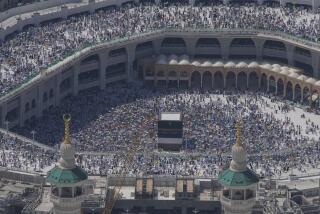Hundreds died during Hajj pilgrimage in Saudi Arabia amid intense heat, officials say
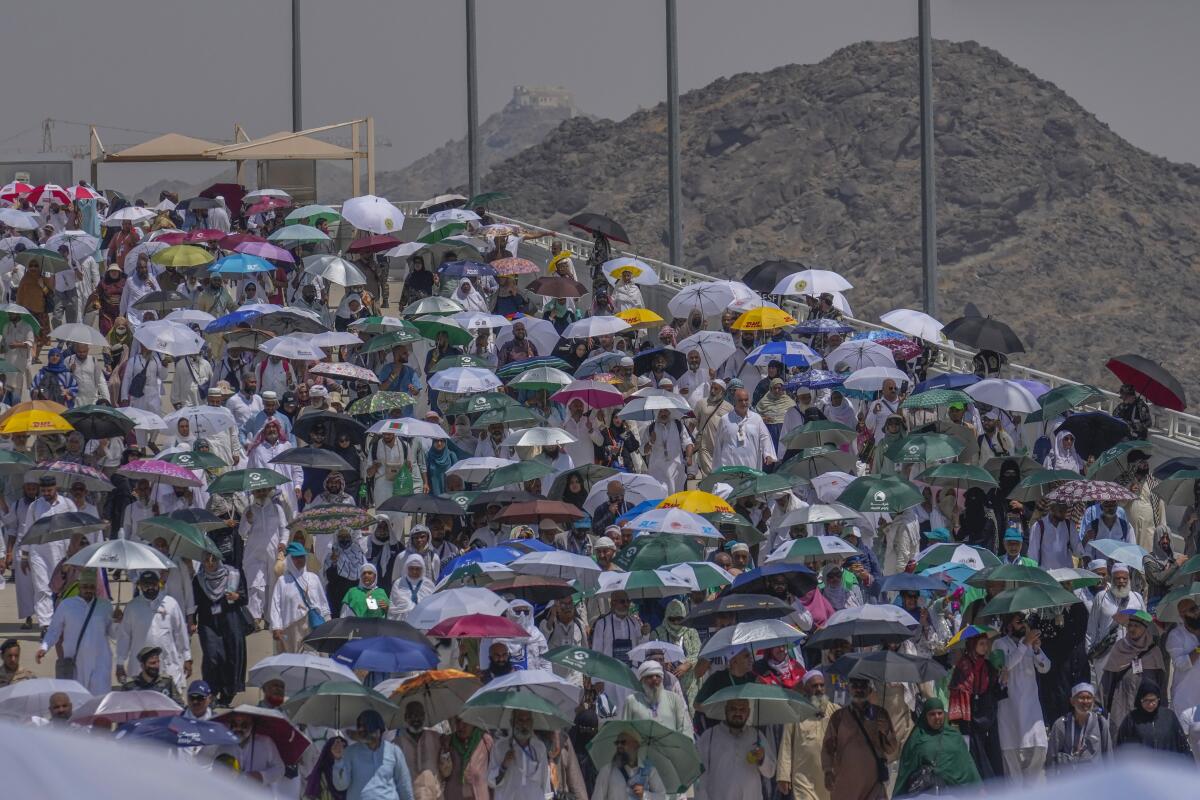
- Share via
MECCA, Saudi Arabia — Hundreds of people died during this year’s Hajj pilgrimage in Saudi Arabia as the faithful faced intense high temperatures at Islamic holy sites in the desert kingdom, officials said Wednesday as people tried to claim their loved ones’ bodies.
Saudi Arabia has not commented on the death toll amid the heat during the pilgrimage, required of every able Muslim once in their life, nor offered any causes for those who died. However, hundreds of people had lined up at the Emergency Complex in the Al-Muaisem neighborhood in Mecca, trying to get information about their missing family members.
One list circulating online suggested at least 550 people died during the five-day Hajj. A medic who spoke to the Associated Press on condition of anonymity to discuss information not released publicly by the government said that the names listed appeared genuine. That medic and another official who also spoke on condition of anonymity said they believed at least 600 bodies were at the facility.
Deaths aren’t uncommon at the Hajj, which has drawn at times more than 2 million people to Saudi Arabia. There have been stampedes and epidemics through the pilgrimage’s history.
Ukrainians displaced by war find new purpose in Shakespeare’s play of love, loss and madness, bringing their blood-red version to the bard’s hometown.
Each year, the Hajj draws hundreds of thousands of pilgrims from low-income nations, “many of whom have had little, if any, pre-Hajj health care,” an article in the April edition of the Journal of Infection and Public Health said. Communicable illnesses can spread among the gathered masses, many of whom saved their entire lives for their trips and can be elderly with preexisting health conditions, the paper added.
However, the number of dead this year suggests something caused the number of deaths to swell. Already, several countries, including Jordan and Tunisia, have said some of their pilgrims died because of the heat that swept across the holy sites at Mecca.
Temperatures on Tuesday reached 117 degrees in Mecca and the sacred sites in and around the city, according to the Saudi National Center for Meteorology. Onlookers saw some people faint while trying to perform the symbolic stoning of the devil.
Masses of pilgrims have embarked on a symbolic stoning of the devil in Saudi Arabia, marking the final days of Hajj pilgrimage.
At the Grand Mosque in Mecca, temperatures reached 125 degrees on Monday though pilgrims had already left for Mina, authorities said.
Others, including many Egyptians, lost track of their loved ones in the heat and the crowds. More than 1.83 million Muslims performed the Hajj in 2024, including more than 1.6 million pilgrims from 22 countries, and around 222,000 Saudi citizens and residents, according to the Saudi Hajj authorities.
On Wednesday at the medical complex in Mecca, an Egyptian man collapsed to the ground when he heard the name of mother among the dead. He cried for some time before grabbing his cellphone and calling a travel agent, shouting: “He left her to die!” The crowd tried to calm the man.
Security appeared tight at the complex, with an official reading out names of the dead and the nationalities, which included people from Algeria, Egypt and India. Those who said they were kin of the dead were allowed inside to identify the deceased.
This year’s hajj is a landmark: the first full pilgrimage after three years when the COVID-19 pandemic reduced the scale of one of Islam’s holiest rites.
The AP could not independently confirm the causes of death for those bodies held at the complex. Saudi officials did not respond to questions seeking more information.
The kingdom’s ruling Al Saud family maintains a major influence in the Muslim world through its oil wealth and management of Islam’s holiest sites. Like Saudi monarchs before him, King Salman has taken the title of the Custodian of the Two Holy Mosques, referring to the Grand Mosque in Mecca home to the cube-shaped Kaaba that Muslims pray towards five times a day, and the Prophet’s Mosque in the nearby city of Medina.
Saudi Arabia has spent billions of dollars on crowd control and safety measures for those attending the annual five-day pilgrimage, but the sheer number of participants makes ensuring their safety difficult.
Climate change could make the risk even greater. A 2019 study by experts at the Massachusetts Institute of Technology found that even if the world succeeds in mitigating the worst effects of climate change, the Hajj would be held in temperatures exceeding an “extreme danger threshold” from 2047 to 2052, and from 2079 to 2086.
Two years ago Thailand became the first country in Asia to decriminalize marijuana. As in California, it hasn’t worked out as planned.
Islam follows a lunar calendar, so the Hajj falls around 11 days earlier each year. By 2029, the Hajj will occur in April, and over the next several years it will fall in the winter, when temperatures are milder.
A 2015 stampede in Mina during the Hajj killed over 2,400 pilgrims, the deadliest incident to ever strike the pilgrimage, an AP count showed. Saudi Arabia has never acknowledged the full toll of the stampede. A separate crane collapse at Mecca’s Grand Mosque, which preceded the Mina disaster, killed 111 people.
The second-deadliest incident at Hajj was a 1990 stampede that killed 1,426 people.
Magdy writes for the Associated Press. AP writer Jon Gambrell in Dubai contributed to this report.
More to Read
Sign up for Essential California
The most important California stories and recommendations in your inbox every morning.
You may occasionally receive promotional content from the Los Angeles Times.

